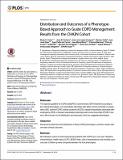Por favor, use este identificador para citar o enlazar a este item:
http://hdl.handle.net/10261/180759COMPARTIR / EXPORTAR:
 SHARE SHARE
 CORE
BASE CORE
BASE
|
|
| Visualizar otros formatos: MARC | Dublin Core | RDF | ORE | MODS | METS | DIDL | DATACITE | |

| Título: | Distribution and Outcomes of a Phenotype-Based Approach to Guide COPD Management: Results from the CHAIN Cohort |
Autor: | Cosio, Borja G.; Soriano, Joan B.; López-Campos, J. L. CSIC ORCID; Calle Rubio, Myriam; Soler-Cataluña, Juan José; Torres, Juan Pablo de; Marín, José María; Martínez, Cristina; Lucas, Pilar de; Mir, Isabel; Peces-Barba, Germán; Feu-Collado, Nuria; Solanes, Ingrid; Alfageme, Inmaculada; Casanova, Ciro | Fecha de publicación: | 29-sep-2016 | Editor: | Public Library of Science | Citación: | PLoS ONE 11(9): e0160770 (2016) | Resumen: | [Rationale] The Spanish guideline for COPD (GesEPOC) recommends COPD treatment according to four clinical phenotypes: non-exacerbator phenotype with either chronic bronchitis or emphysema (NE), asthma-COPD overlap syndrome (ACOS), frequent exacerbator phenotype with emphysema (FEE) or frequent exacerbator phenotype with chronic bronchitis (FECB). However, little is known on the distribution and outcomes of the four suggested phenotypes. [Objective] We aimed to determine the distribution of these COPD phenotypes, and their relation with one-year clinical outcomes. [Methods] We followed a cohort of well-characterized patients with COPD up to one-year. Baseline characteristics, health status (CAT), BODE index, rate of exacerbations and mortality up to one year of follow-up were compared between the four phenotypes. [Results] Overall, 831 stable COPD patients were evaluated. They were distributed as NE, 550 (66.2%); ACOS, 125 (15.0%); FEE, 38 (4.6%); and FECB, 99 (11.9%); additionally 19 (2.3%) COPD patients with frequent exacerbations did not fulfill the criteria for neither FEE nor FECB. At baseline, there were significant differences in symptoms, FEV1 and BODE index (all p<0.05). The FECB phenotype had the highest CAT score (17.1±8.2, p<0.05 compared to the other phenotypes). Frequent exacerbator groups (FEE and FECB) were receiving more pharmacological treatment at baseline, and also experienced more exacerbations the year after (all p<0.05) with no differences in one-year mortality. Most of NE (93%) and half of exacerbators were stable after one year. [Conclusions] There is an uneven distribution of COPD phenotypes in stable COPD patients, with significant differences in demographics, patient-centered outcomes and health care resources use. |
Versión del editor: | https://doi.org/10.1371/journal.pone.0160770 | URI: | http://hdl.handle.net/10261/180759 | DOI: | 10.1371/journal.pone.0160770 | E-ISSN: | 1932-6203 |
| Aparece en las colecciones: | (IBIS) Artículos |
Ficheros en este ítem:
| Fichero | Descripción | Tamaño | Formato | |
|---|---|---|---|---|
| journal.pone.0160770.PDF | 1,6 MB | Adobe PDF |  Visualizar/Abrir |
CORE Recommender
PubMed Central
Citations
25
checked on 02-may-2024
SCOPUSTM
Citations
49
checked on 02-may-2024
WEB OF SCIENCETM
Citations
30
checked on 27-feb-2024
Page view(s)
162
checked on 09-may-2024
Download(s)
140
checked on 09-may-2024

